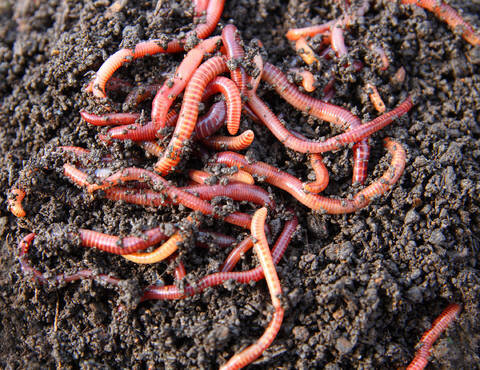Red wigglers: Perfect for new gardeners
Red wigglers: Perfect for new gardeners
Blog Article
Obtain one of the most Out of Your Garden Compost With Red Wigglers
The combination of red wigglers right into your composting system can significantly enhance the efficiency and effectiveness of waste management methods. These worms are not only proficient at damaging down organic products yet likewise contribute to the development of top quality garden compost that enhances soil health and wellness.
Comprehending Red Wigglers
Comprehending red wigglers is crucial for any individual interested in vermicomposting, as these worms play a crucial role in damaging down natural matter. Medically called Eisenia fetida, red wigglers are differentiated by their reddish-brown color and slim bodies, normally determining in between 3 to 4 inches in length. Unlike earthworms, which prosper in soil, red wigglers choose a damp, organic-rich atmosphere, making them perfect for composting systems.
These worms are renowned for their voracious hunger, eating half their body weight in organic material daily. This capacity allows them to rapidly disintegrate cooking area scraps, yard waste, and other eco-friendly materials, transforming them right into nutrient-rich garden compost. Red wigglers grow in temperatures ranging from 55 ° F to 77 ° F, requiring mindful monitoring of their atmosphere to make certain optimal activity.
Moreover, red wigglers reproduce swiftly, doubling their population approximately every 3 to 4 weeks under optimal conditions. This rapid reproduction is vital for keeping an effective composting operation. red wigglers. Recognizing their biology and actions is crucial for anybody wanting to harness their potential in lasting waste administration practices
Advantages of Vermicomposting
Vermicomposting deals many benefits that expand past basic waste reduction. This innovative approach leverages the all-natural decomposition capabilities of red wigglers to transform natural waste right into nutrient-rich garden compost, enhancing soil health and fertility. The resulting vermicompost is bristling with valuable microbes, which can enhance dirt structure and increase nutrient schedule for plants.

In addition, vermicomposting can be exercised in numerous settings, making it available for urban residents and those with minimal outside area. It needs very little investment and can be easily handled inside or outdoors, making it ideal for numerous way of lives.
Using vermicompost also promotes much healthier plant growth by boosting microbial activity, boosting water retention, and providing necessary nutrients. Gardeners and farmers that integrate vermicompost into their methods often observe boosted plant returns, making vermicomposting a lasting selection for both waste administration and farming efficiency.
Establishing Up Your Worm Bin
Developing an effective worm container is necessary for successful vermicomposting, and with simply a few crucial components, any person can establish a reliable system. Start with an appropriate container; a plastic or wood bin with a lid works well. Preferably, the bin should be in between 10 to 18 inches deep to provide enough space for the worms to prosper.
Guarantee correct ventilation by piercing small openings in the sides and lid, enabling air movement while keeping wetness. Keep a balance between dampness and drainage; the bin must perspire but not special info soaked. A layer of bed linens, such as shredded paper or cardboard, offers a habitat for the worms and help in dampness retention.
Take into consideration the location of your worm bin (red wigglers). By adhering to these standards, you will develop a conducive atmosphere for red wigglers, laying the foundation for an effective vermicomposting venture.
Feeding Your Red Wigglers

Prevent feeding them meat, dairy, and oily foods, as these can bring in pests and develop unpleasant smells. In addition, it is critical to chop or shred bigger things to facilitate quicker decay, ensuring your worms can access the nutrients extra efficiently.
Small amounts is vital; overfeeding can lead to anaerobic problems, harming the worms and decreasing the composting procedure. Monitor the container for uneaten food and change your feeding regimen accordingly. A general rule is to supply concerning half a pound of food per pound of worms each week.
Last but not least, keeping wetness is important. Goal for a moist, however not soaked, atmosphere, as moisture help in the failure of food and supports worm activity. By meticulously handling their diet, you can enhance the efficiency of your red wigglers in transforming organic waste right into abundant compost.
(red wiggler worms)
Harvesting and Using Compost
After numerous weeks of thorough composting, you will notice that the abundant, dark compound generated by your red wigglers is prepared for harvest. One reliable method is to utilize a light resource; red wigglers are sensitive to light and will certainly delve deeper into the material, enabling you to scoop out the leading layer of compost.
As soon as harvested, the compost can be made use of in various applications. Mix it into yard dirt to improve framework and fertility, or utilize it as a top clothing for potted plants. It can also be thinned down in water to develop a nutrient-rich liquid plant food, commonly called "worm tea." This tea can be used straight to plants, offering them with an increase of vital nutrients.
Keep in mind to keep any type of extra compost in a great, dry location to keep its high quality. By properly harvesting and using the garden compost generated by red wigglers, you not only enrich your garden but also promote sustainable horticulture techniques.
Verdict
Integrating red wigglers into composting techniques dramatically improves the efficiency of natural waste transformation. Eventually, the integration of red wigglers in composting adds to lasting gardening, reduces land fill waste, and advertises environmental stewardship with reliable source recycling.
Report this page